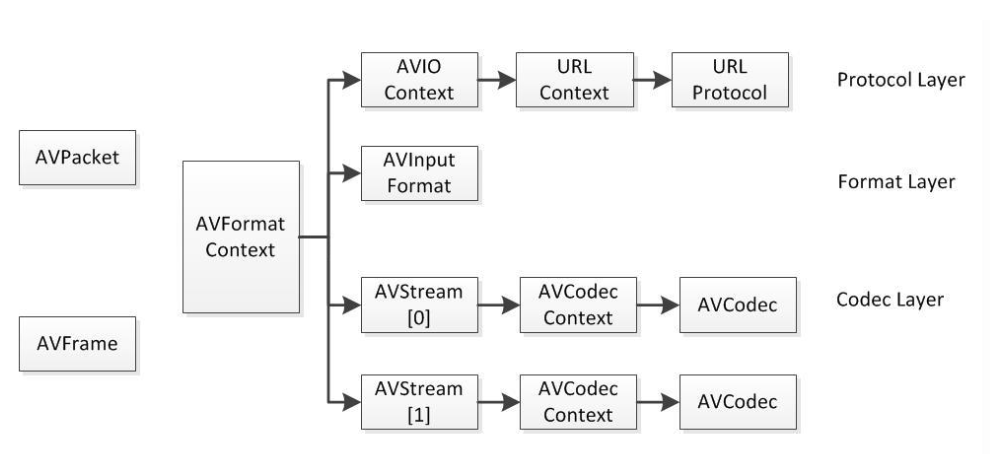FFmpeg 6.0 中 AVFormatContext 结构体
 AVFormatContext 是 FFmpeg 比较核心的结构,贯彻处理核心内容,毕竟是上下文。
AVFormatContext 是 FFmpeg 比较核心的结构,贯彻处理核心内容,毕竟是上下文。
AVFormatContext
1
2
3
4
5
6
7
8
9
10
11
12
13
14
15
16
17
18
19
20
21
22
23
24
25
26
27
28
29
30
31
32
33
34
35
36
37
38
39
40
41
42
43
44
45
46
47
48
49
50
51
52
53
54
55
56
57
58
59
60
61
62
63
64
65
66
67
68
69
70
71
72
73
74
75
76
77
78
79
80
81
82
typedef struct AVFormatContext {
const AVClass *av_class; //AVClass用于打印log和AVOption的引用,由avformat_alloc_context() 函数创建
const struct AVInputFormat *iformat; //输入文件容器格式,大部分是函数指针
const struct AVOutputFormat *oformat; //输出文件容器格式,大部分是函数指针
//格式化私有数据,format/oformat不为空时,用支持AVOptions的结构
//封装时 avformat_write_header 设置 oformat->priv_data,占用内存空间长度由oformat->priv_data_size
//解封 avformat_open_input 设置 iformat->priv_data
void *priv_data;
AVIOContext *pb; //管理输入输出数据的结构体
//标记信号流属性。AVFMTCTX_*的集合。该字段的设置基本上都在各个解封装器的read_header方法中,例如flv_read_header函数。
//AVFMTCTX_NOHEADER 表示不存在header(流是动态添加的)
//AVFMTCTX_UNSEEKABLE 表示流绝对不可定位,尝试调用seek函数将失败。 例如 HLS 可能在运行时动态更改
int ctx_flags;
unsigned int nb_streams; //音视频流的个数(视频、音频、字幕等)
AVStream **streams; //音视频流
char *url; //文件名 或url路径
int64_t start_time; //一般没用以streams为准,AVSTREAM 推导出来,在解封装的时候有意义,由libavformat模块赋值。
int64_t duration; //一般没用以streams为准,时长,单位:微秒us,转换为秒需要除以1000000
int64_t bit_rate; //一般没用以streams为准,比特率(单位bps,转换为kbps需要除以1000)
unsigned int packet_size; //数据包大小和下面 ma_delay 是不是流时候使用
int max_delay;
int flags; //标记(源码有define定义) avformat_open_input / avformat_write_header
int64_t probesize; //从输入流探测数据包的大小 byte 在avformat_open_input之前设置 默认5000000
int64_t max_analyze_duration; //最大的分析数据的时长 微秒,在检测编码格式时使用,在avformat_find_stream_info前设置
const uint8_t *key; //关键字
int keylen;
unsigned int nb_programs; //
AVProgram **programs; //指向实际节目的指针%
enum AVCodecID video_codec_id; //强制视频编解码器 ID。解复用: 由用户设置
enum AVCodecID audio_codec_id;
enum AVCodecID subtitle_codec_id;
unsigned int max_index_size; //每个数据流索引的最大内存容量(以字节为单位),超过截断
unsigned int max_picture_buffer; //用于缓冲从实时捕捉设备获取的帧的最大内存容量(以字节为单位)。
unsigned int nb_chapters;
AVChapter **chapters; //指向章节数据的指针%
AVDictionary *metadata; //文件元数据
int64_t start_time_realtime; //码流开始的实际时间,以毫秒为单位
int fps_probe_size; //表明使用了多少帧用于格式检测
int error_recognition; //错误检测的阈值
AVIOInterruptCB interrupt_callback; //IO层用户自定义的回调结构
int debug;
int64_t max_interleave_delta; //交错的最长缓冲时间 av_interleaved_write_frame() 将等待每个数据流至少有一个数据包后,才会将任何数据包实际写入输出文件。
int strict_std_compliance;
int event_flags; //文件中发生的事件的标志,avfmt_event_flag_*。 avformat_open_input avformat_find_stream_info av_read_frame 设置, 事件处理完成后,用户必须清除标记。
int max_ts_probe; //在等待第一个时间戳时要读取的最大数据包数量。仅限解码。
int avoid_negative_ts; //在多路复用过程中避免负时间戳。 AVFMT_AVOID_NEG_TS_ 使用 av_interleaved_write_frame() 时效果更好
int ts_id; //传输流的ID
int audio_preload; //以微秒为单位的音频预载
int max_chunk_duration; //以微秒为单位的最大分块时间
int max_chunk_size; //以字节为单位的最大块大小
int use_wallclock_as_timestamps; //强制使用挂钟时间戳作为数据包的 pts/dts * 如果存在 B 帧,则会产生未定义的结果。
int avio_flags; //avio 标志,用于强制 AVIO_FLAG_DIRECT
enum AVDurationEstimationMethod duration_estimation_method; // 持续时间字段可通过多种方式估算,该字段可用于 了解持续时间的估算方式。 编码:未使用 - 解码: 由用户读取
int64_t skip_initial_bytes; //打开数据流时跳过初始字节
unsigned int correct_ts_overflow; // 纠正单个时间戳溢出
int seek2any; //强制查找任何(也包括非关键帧)帧
int flush_packets; //在每个数据包之后刷新 I/O 上下文 编码
int probe_score; //格式探测得分 0-100
int format_probesize; //从输入中读取的最大字节数,以便识别 ref AVInputFormat "输入格式"。仅在格式未被调用者明确设置时使用
char *codec_whitelist; //以','分隔的允许解码器列表
char *format_whitelist; //以','分隔的允许使用的解码器列表
int io_repositioned; //IO 重新定位标志
const AVCodec *video_codec;
const AVCodec *audio_codec;
const AVCodec *subtitle_codec;
const AVCodec *data_codec;
int metadata_header_padding;
void *opaque; //用户数据。 这里存放用户的一些私人数据。
av_format_control_message control_message_cb;
int64_t output_ts_offset; //输出时间戳偏移,以微秒为单位。
uint8_t *dump_separator; //转储格式分隔符。可以是", "或"\n "或其他任何东西
enum AVCodecID data_codec_id; //强制数据 codec_id。
char *protocol_whitelist; // 以','分隔的允许协议列表。
int (*io_open)(struct AVFormatContext *s, AVIOContext **pb, const char *url,
int flags, AVDictionary **options); //用于打开新 IO 流的回调。
void (*io_close)(struct AVFormatContext *s, AVIOContext *pb); //已过时,请使用 io_close2
char *protocol_blacklist; //',' separated list of disallowed protocols.
int max_streams; //流的最大数量
int skip_estimate_duration_from_pts; //跳过estimate_timings_from_pts中的持续时间计算
int max_probe_packets; //可探测的最大数据包数量
int (*io_close2)(struct AVFormatContext *s, AVIOContext *pb); //关闭使用 AVFormatContext.io_open() 打开的数据流的回调。
} AVFormatContext;
本文由作者按照 CC BY 4.0 进行授权